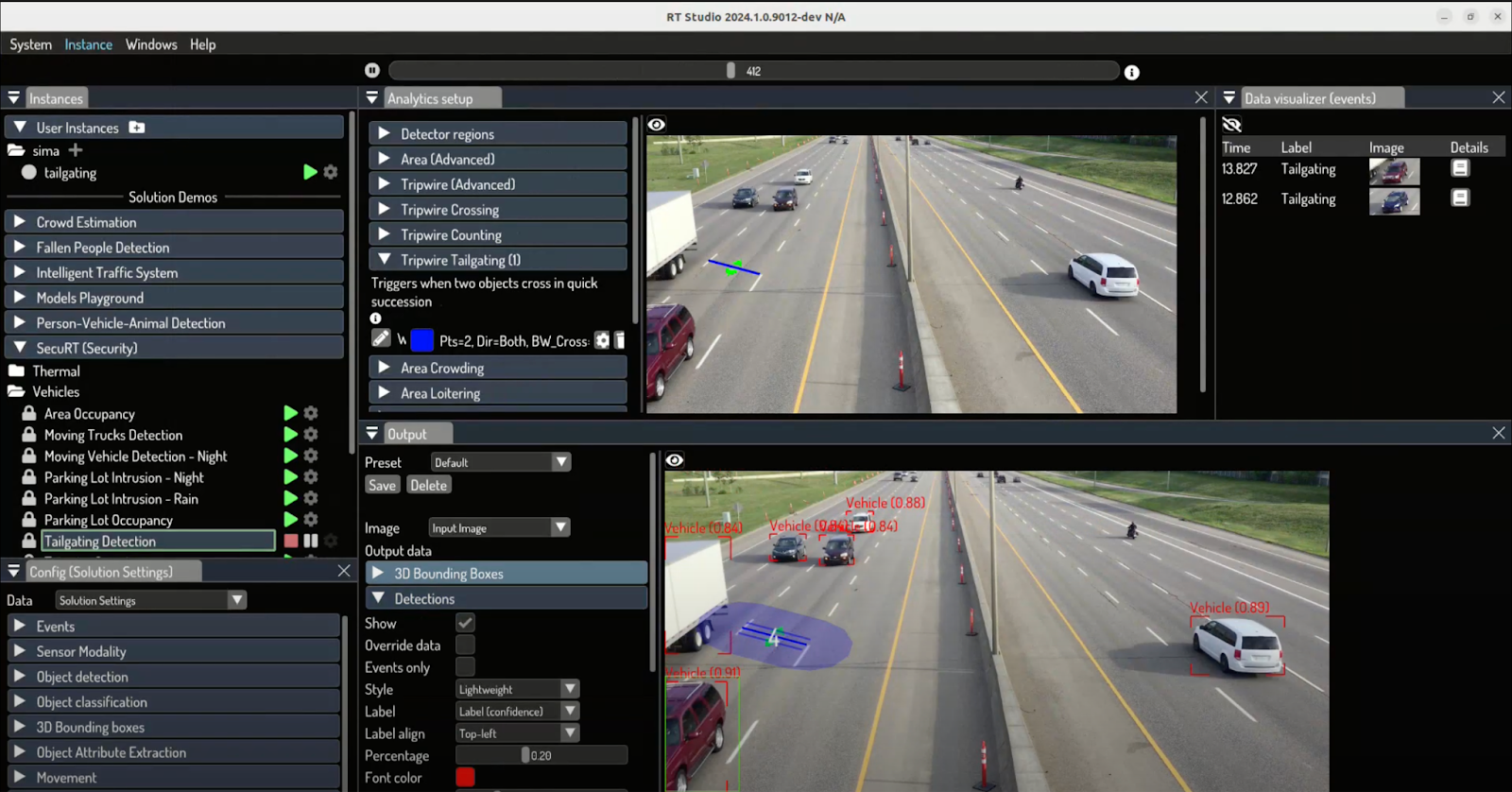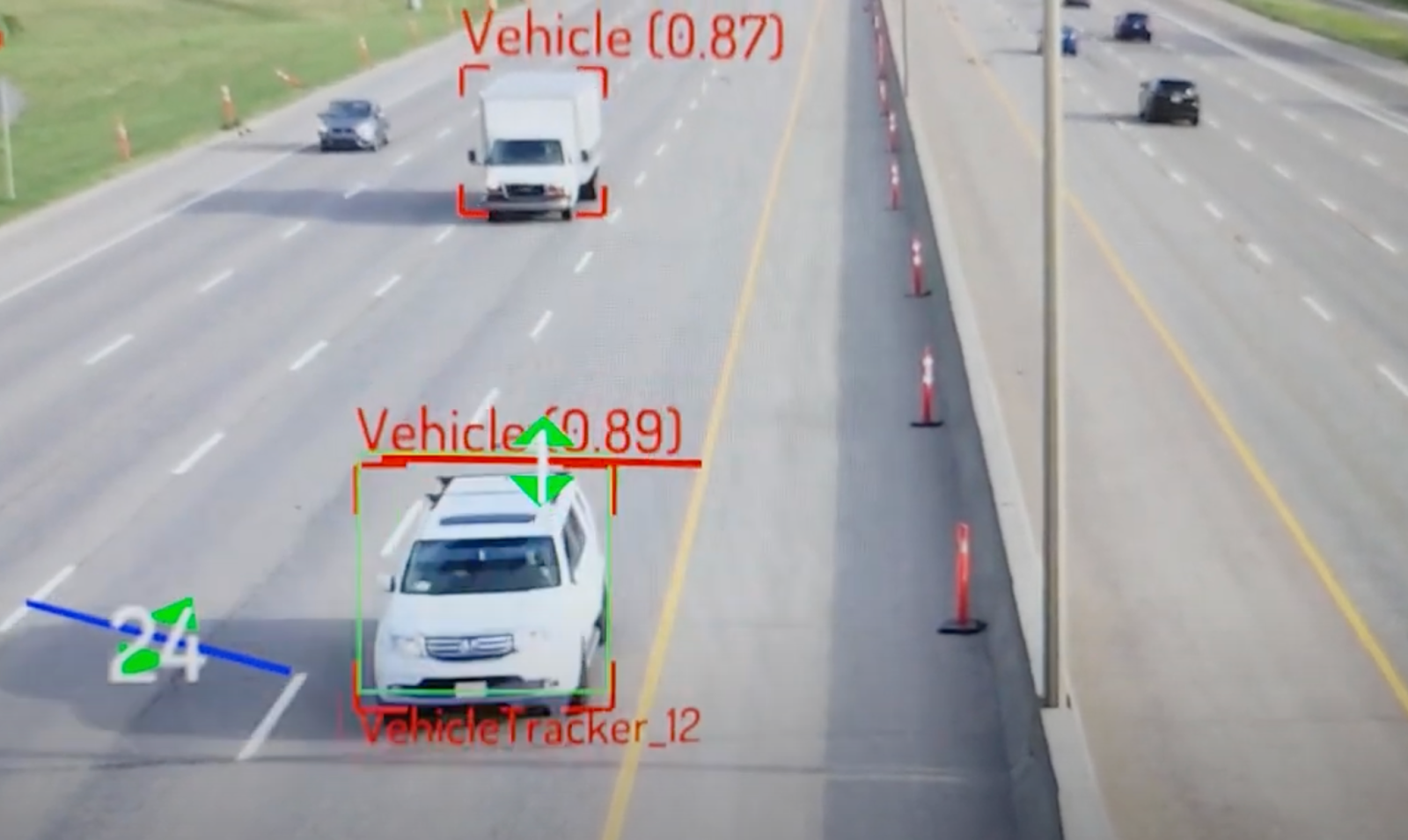Introducing the SiMa.ai Smart Cities Solution on Supermicro Compact Edge ML Server Running CVEDIA AI Video Analytics
Operational efficiency of infrastructure is a key priority for local government agencies and transportation authorities. Real-time traffic monitoring is an essential asset for achieving this objective by continuously improving traffic management to enhance public safety and reduce environmental impact through adaptive urban planning. Building a traffic monitoring application with real-time capabilities is a complex task, considering factors such as latency, privacy, scalability, adaptability and cost. Embedded edge ML-based solutions are ideal when compared against cloud-based approaches due to the above system constraints. However, developing a custom ML model to analyze fast-moving highway traffic and getting these models to run efficiently at the edge is challenging. It requires specialized expertise, time, and resources. The development cycle may take months to complete.
The SiMa.ai smart city solution helps local government agencies and transportation authorities deploy critical infrastructure and transportation applications with embedded ML-based solutions. The SiMa.ai smart city edge solution was created in partnership with Supermicro and AI software vendor CVEDIA. The solution integrates the CVEDIA AI video analytics onto the edge appliances from SuperMicro with the ML pipeline running natively on the SiMa.ai MLSoC using Palette software.
The result is an out-of-the-box solution that is equipped to add value immediately for customer use cases such as real-time traffic monitoring with:
1. Improved Key Performance Indicators (KPIs): Better performance (accuracy, latency, throughput and power) for edge devices
2. Increased Flexibility: Support for a wider range of models, from smart retail to industrial automation.
3. Faster Time-to-market: Ready-made solutions made possible by the robust SiMa.ai partner ecosystem help organizations get up and running quickly
Real-Time Traffic Monitoring with Edge Optimized AI/ML
This post demonstrates how to set up a computer vision-based real-time traffic monitoring system for the local government agencies using the SiMa.ai smart city solution. The real-time traffic monitoring application tracks specific zones. When vehicles move through each zone, they are counted and identified, allowing the system to then track specific vehicles as they move from one zone to the next. The system includes a feature to identify tailgating and other unsafe driving behaviors. The traffic monitoring application can be further extended with custom business logic, such as driver notifications using precise vehicle tracking.
This traffic monitoring application shows the power of the SiMa.ai MLSoC working in real-time. Let’s dive further into the challenges associated with this particular use case, and why our joint solution works so well to address those challenges.

Fig. 1
The use case highlighted in this blog is a real-time traffic monitoring application for smart cities, with built-in features to track and analyze critical activities on the road. These features include moving vehicle detection, tailgating, parking lot occupancy and intrusions plus others, as indicated in Fig. 1.
Fig. 2 illustrates the high-level architecture with the ML inference flow on a SiMa.ai MLSoC at the edge.

Fig. 2
Host: Supermicro edge appliance running Ubuntu 20.04 with CVEDIA-RT application installed to interface with SiMa.ai MLSoC through a PCIe interface.
Cameras: Capture live feed from the city streets or highway typically connected through standard RJ45/Ethernet interface with the ability to support up to 8 Full-HD channels at 30FPS.
Ingress / Egress: Refers to the data flowing in and out of the Palette software running on the SiMa.ai MLSoC for real-time processing.
Decode / Encode: Refers to the multimedia decoding and encoding that might be needed for the data processing pipeline.
SiMa.ai Palette Software: Data compute blocks on a SiMa.ai MLSoC at the edge include the following steps:
1. Data pre-process (quantization + tessellation)
2. Inference on the pre-processed data
3. Data post-process (de-tessellation + de-quantization
The ML inference workflow on the pre-processed data begins with the object detection model on a SiMa.ai MLSoC at the edge. The object detection model crops the image and passes the result to the anomaly-detection model that classifies the vehicles. The anomalous condition vehicle images and model results are sent to the host database for additional post-processing analytics.
CVEDIA-RT: Customer application running on the host machine with native SDK integration to highlight the real-time data processing capabilities and various features or modes associated with the traffic monitoring solution as indicated in Fig. 1.
The entire ML inference workflow, running on the SiMa.ai MLSoC with a Yolo-V6 model based pipeline using the single video channel at full-HD at 30FPS, consumes ~7.5W power.
Why is This a Complex and Difficult Problem to Solve?
Fig. 3 refers to the snapshot captured from the traffic monitoring application that shows vehicles moving at a high speed — between 60 and 80 miles per hour. At these speeds, tracking cars and extracting information from them as they pass represents a very difficult machine learning problem. If the underlying platform cannot compute the workloads of the entire ML pipeline at the necessary pace, it simply cannot satisfy the use case because the application needs to analyze data in real time. The CVEDIA-RT profiler & SiMa.ai Palette SDK provide tools to analyze pipeline modules and associated latencies, captured real-time to further fine-tune the application accordingly. Public MLPerf benchmarks and other assessments of FPS/Watt done in the past indicate clear superiority of SiMa.ai solutions at 10x performance over CPU and GPU based approaches.

Fig. 3
With a cloud based solution, tracking devices must send data back to a remote server for analysis rather than natively bind them to an edge device. This delays response times and opens up unacceptable data (privacy and security) vulnerabilities. SiMa.ai edge based solutions, on the other hand, process all data locally, which provides key benefits around latency, privacy and cost. Comparative cost studies at SiMa.ai customers switching from cloud-based to edge-local systems indicate cost savings reaching as high as 90% with scale.
Taking it to the Streets
A typical use-case is a county or a city collecting information, tracking cars on a local stretch of freeway to gauge traffic congestion level distributions across peak & off-peak travel times. The traffic information collected is then analyzed to create time estimates for drivers on the road.
- Accuracy and Latency: This use case only works in real-time. Data has to be up-to-date and recent in order to provide an accurate and useful drive time estimate.
- Privacy and Security: Data needs to be safe and secure. These are private citizens on the road in vehicles with identifying markers, like license plate numbers. In the wrong hands, that information could allow bad actors to track the travel patterns of specific individuals, compromising public safety and privacy.
- Power and Cost: The cost of deploying and running the application has to be low and predictable in order to fit into the fixed budget of a local government.
Together, SiMa.ai, Supermicro and CVEDIA have built a solution that exceeds these requirements by integrating best-in-class hardware, software and intelligence into a single production-ready platform.
Unique Edge ML Solutions From SiMa.ai and Partners
There are three primary performance capabilities that we recognize are key to customers for edge AI/ML — accuracy, latency and power efficiency. These are the critical metrics measured for any edge solution.
Most solutions that meet these requirements are prohibitively expensive for all but the largest enterprises. SiMa.ai, with its ONE platform for all edge AI, brings that cost factor down significantly without compromising on overall system performance.
Many existing approaches only address one piece of the puzzle — ML inferencing. These solutions perform the inferencing portion of the task, but then offload the rest of the work onto a separate device (a host or a co-processor) to reduce power. This adds cost and complexity. At SiMa.ai, we believe that customers should not have to compromise on performance, cost or power. Our MLSoC runs the entire ML application pipeline, from ingestion to output - providing real-world deployable solutions like the SiMa.ai, Supermicro and CVEDIA smart cities solution, which are optimized for performance (accuracy, latency, power) and cost efficiencies.
For more information, or to talk to a SiMa.ai expert about your own edge ML project, contact us here: https://sima.ai/contact-us/.
